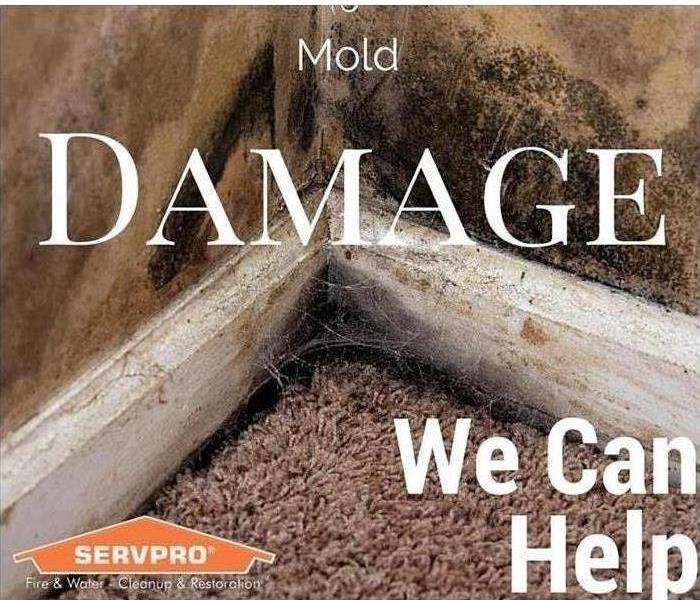Understanding the Science Behind Molds and Mold Remediation
5/22/2018 (Permalink)
Understanding the Science Behind Molds and Mold Remediation
The microscopic mold spores that eventually spread like a conflagration bringing about a mold infestation can be found pretty much everywhere. Their common spreading grounds include homes and business premises with plumbing or roof leaks.
All it takes for mold growth from the microscopic spores to a palpable infestation or the massive mold growth behind walls is a damaging water incidence and a 48 to 72 hours’ time-stretch. During this time you may arrange for the water to be removed so as to circumvent the mold in home problem that’s about to blow up.
Alternatively, you may get a licensed mold in home removal professional to help you inspect it and suggest the right course of action to tackle commercial mold damage.
Understanding Molds
The spreading of mold fungus mostly occurs as a result of water intrusion into a property or dry rot. No home is completely safe from the mold growth behind walls; considering they shoot from microscopic mold spores that often float about in the air or dry rot and are likely to enter your home through any available opening, including your windows, AC/heating system, and the door.
Mold growth thrives in the presence of moisture, not dry rot as many people love to assume. Meaning, they’ll be growing into colonies within two to three days whenever they’re exposed to water.
Mold in home or mold growth behind walls is detested for a number of reasons, among them is the fact that they tend to produce a very strong smelly odor. This is particularly the case with black molds. Speaking of which, mold remediation and restoration company often use the musty odor they produce to identify infested areas.
Also worth noting is that mold in home growth can also be supported by a higher-than-normal indoor humidity; to wit, anything above 45 percent.
Prior to any mold remediation process, it’s recommended that you make sure the humidity or moisture problem you’re facing in your home is properly addressed. Otherwise, it would just be a matter of time before the problem gets you back to square one.
Steps to Tackle a Commercial Mold Damage
• Use bleach and water solution to clean up the infested area. Read this bearing in mind that NO other household disinfectant can destroy black molds. It’s also important that you try to keep any member of your family or office staff away from the affected area.
• If the mold damage is contained within a room, then try to keep the door closed to prevent it from spreading further. The same can be said about mold growth behind walls.
• Never use a fan to dry the affected area. This will only disturb the spores, the result of which you’ll be spreading them somewhere else.
• In the event of a gigantic mold growth behind walls, you might want to call a mold mitigation or restoration company to come and help you tackle the problem.
You might also want to notify your insurance company. If your mold in home insurance policy happens to also cover mold removal and mitigation, you might want to notify them as soon as it’s reasonably possible to avoid creating up unnecessary complications.
Molds, Fungus and Mildews
While many people can’t tell the difference between molds, fungus and mildew, the difference between them is so striking to go unnoticeable. Of course, all the three are closely related.
First, be reminded that fungus is neither an animal nor plant. Neither does fit in the bacterium basket. If anything, it has its own unique kingdom of classification, and in which both mildew and molds happen to be subsets.
Both molds and mildews spread easily and thrive in the presence of water. They also have an almost similar smelly odor. But despite these common features, the two have their fair share of differences.
While molds feature multiple identical nuclei that tend to form black or green patches as they grow, mildews on the other hand have a flat growth with a tendency to lightly hang on surfaces as they grow.
Mildews can be found growing on paper, fabrics, damp surfaces and other organic materials in the house, whereas molds tend to grow on food, dry rot and permanent structures such as crawl spaces and walls.
Black Mold in home
As hinted by the sinister name, black mold is the most dreaded mold growth species. Its name alone is enough to strike fear in the hearts of many homeowners.
Easily identified by its black color, removing the black mold is even more problematic as opposed to the removal of its gray and green equals with a NOT so bad smelly odor.
Its smelly odor is also so intense and no kind of deodorization is enough to rid it off completely.
It’s for these reasons that it’s recommended that you reach out to a mold damage restoration and deodorization company for help every time you experience commercial mold damage.
Difference between Mold removal and Mold Remediation
As already mentioned, the mold grows from the tiny microscopic spores that naturally exist almost everywhere—both indoors and outdoors. Meaning it’s literally impossible to completely remove them from your home or premise.
This is to say any mold deodorization or Restoration Company claiming to also offer mold removal services is only selling a fallacy to clueless clients.
If you’re planning to have the problem tackled professionally, then you might want to pick on a restoration company that completely understands the science behind molds growth and their mitigation.
Suffice it to say that the best mold damage mitigation or deodorization company to settle for is one that offers mold remediation services and nothing about mold removal services. So by definition, mold remediation or mitigation focuses on reverting mold damage levels to manageable, natural levels instead of selling false hope to clueless consumers experiencing commercial mold damage.





 24/7 Emergency Service
24/7 Emergency Service
